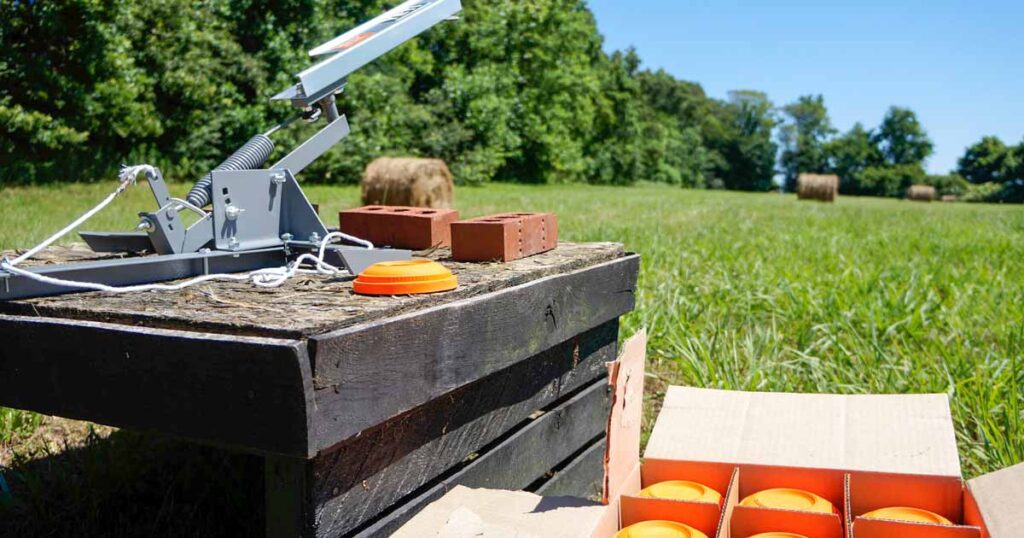The first time I went skeet shooting, I missed so often and by such wide margins that people laughed at me. I deserved it.
I didn’t mind the laughter—or failing, either, even in front of people. It’s (almost) enjoyable; it’s how I learn. But I do mind failing without knowing how to get better. That feels pointless. I had not been trained properly in skeet shooting and had no clue what I was doing wrong. For that reason, I never wanted to shoot skeet again, and I had no intention of doing it until I visited Primland Resort—a breathtaking 12,000-acre lodge in the Blue Ridge Mountains that Travel and Leisure called one of the best resorts in the South.
Sammy Howell, a Primland shooting instructor, drove us along a mountain road. Grandeur swallowed us as I described my struggles. At least here, high up in the mountains, nobody would see me fail except Howell. But he assured me he encounters guests like me frequently. To teach them, he stands behind them and watches, offering tips, as they follow the target with their unloaded shotgun. After a few minutes, he loads the gun and tells them to fire on his command. “When I say ‘shoot’—boom! They’ll break it—every time,” he says.
I arrived at Primland while researching how to take (and hit) the Big Shot, and skeet shooting provided an opportunity to test what I had learned. After hearing Howell’s instruction, I was 98% sure I would shoot better.
As we walked up to the wooden shooting platform, 98 became 100. We rehearsed like he described. I hit the first six—more than I hit that entire first day—and, all told, shot like a different person. That gave me Big Shot lesson No. 1: Proper coaching and training are crucial.
Here’s what else I have learned.
1. First, take a bunch of small shots. Then, push yourself.
The tech world dumps jobs every day, while nearly 90% of construction companies can’t find enough qualified workers. That volatility pushes some people to want to take the Big Shot. It makes others skittish, because if they miss, they don’t know what they’ll return to.
Statistics (and common sense) show that the younger you are, the more willing you are to take the Big Shot, whether that’s changing jobs or careers. You’re also more likely to miss because you don’t know what you don’t know. As painful as missing is, it’s invaluable. I learned that on the Appalachian Trail during my first overnight backpacking trip.
It rained so hard the trail became an inch-deep creek of running water. My cheap rain gear failed (didn’t-know-better mistake 1), and the clothes on my body and in my backpack were soaked. I also committed what I now consider a comical error of wearing cotton (didn’t-know-better mistake 2), which takes forever to dry. On top of that, the temperature was 10 degrees colder than I was prepared for (didn’t-know-better mistake 3). High 50s and sunny is awesome hiking weather. High 40s and drenched is borderline dangerous. My inexperience put me at risk.
By luck, my group stumbled upon a shelter that protected us from the elements. Without that shelter, I might have never hiked again. With it, I learned valuable lessons—most notably about how failing in one Big Shot prepares me for the next. Since then, I have hiked in Virginia, Alaska, California, New Mexico and many more places, each a little more daring, each one applying what I had learned previously.
This spring, 11 years after that horrible first hike, I planned and executed a three-day, two-night hike in the Ozarks. I led a group of 14 others—a Big Shot I never could have taken without attempting so many smaller shots first.
2. Don’t worry about what someone else’s big shot looks like.
Josh Wise is known in NASCAR as the driver whisperer. An optimization coach, he coaxes stellar performances out of drivers with a holistic approach focusing on craft, fitness, wellness, mental toughness and more. He’s so good that some of his clients won’t talk about him because they don’t want anyone to know what’s fueling their Big Shots.
In May, I embedded with Wise as his clients practiced. He asked them to run what I’ll call Big Shot laps (his term is more colorful) followed by conservative laps (which he calls “no-slip”). A Big Shot lap is aggressive and marked by the tires spinning and the car getting sideways in turns. In a no-slip lap, neither of those things are supposed to happen.
I watched a driver named Sheldon Creed. My takeaway was not what Creed’s Big Shot laps looked like but that even his conservative laps were aggressive—perhaps as aggressive as another driver’s Big Shot laps. That’s because Creed grew up in off-road racing, a style of driving in which the tires spin and the car slides on every lap. That means he’s more comfortable being uncomfortable. While some drivers have to be pushed to be more aggressive, Creed had to be told to be more intentional about taking it easy.
3. You need to be ready when your chance comes, recognize when it does and acknowledge you are not in control.
“A legacy of weirdness” is how J.P. Morgan Chief Global Strategist David Kelly described the post-pandemic job market. “A recession is coming!” says one headline. “No, it’s not!” says the next. It’s challenging to take a Big Shot amid uncertainty. The best you can do is make decisions based on the available information, however incomplete it is.
I learned this while taking surfing lessons and conducting research into how artificial intelligence and human experience put surfers on a never-ending quest for perfect waves. At the risk of oversimplifying, AI refines billions of data points to predict what the waves will be like, and then surfers paddle out to enjoy what AI predicted.
But AI forecasts what all waves will be like, not what each wave will be like. My instructor watched the waves as they approached and only let me try to surf those that looked good. I rode the first two almost all the way in. His third choice, while indistinguishable from the first two, immediately crashed on my head as if I opened the attic door in my ceiling and a trunk fell out.
I asked my instructor why that wave crashed while the others rolled. He shrugged. The not knowing is part of the fun. Some waves crash, some roll. The best we can do is pick a wave that looks good, stand up and ride—for however long it lasts.
This article originally appeared in the September/October 2023 issue of SUCCESS magazine. Photo by Bennett Walker/Shutterstock.com










